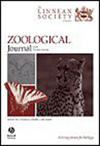Regional selection pressure and heterogeneous transitions shape diverse colour pattern in Pachyrhynchus weevils (Coleoptera: Curculionidae)
IF 2.8
2区 生物学
Q1 ZOOLOGY
引用次数: 0
Abstract
The evolution of colouration and patterns is a captivating aspect of biological research shaped by multiple factors. Pachyrhynchus weevils, known for their unpalatable nature owing to their tough elytra, inhabit the tropical regions of the Philippines and display intricate elytral patterns that contribute significantly to species diversity. To investigate the evolution of patterns in Pachyrhynchus weevils, we used the ultraconserved elements method to construct a phylogeny encompassing 99 species and to assess pattern evolution. These weevils exhibit flexibility in pattern expression, with a trend towards pattern retention and diversification rather than pattern loss, as indicated by the analyses of evolutionary transition rates. Furthermore, using phylogenetic generalized linear regression, we found that patterns are associated with specific geographical regions, suggesting that convergent evolution of patterns occurs among weevils. Finally, our analysis revealed that speciation rates are not consistent with the rates of pattern diversification. These results highlight the complexity of pattern evolution and suggest that varying selection pressures in different areas, such as predation, combined with frequent transitions in patterns, might contribute to the evolution of these patterns, potentially leading to a rich diversity among these island-dwelling insects.区域选择压力和异质过渡塑造了象鼻虫(鞘翅目:食虫科)多样的颜色模式
色彩和图案的进化是生物研究中受多种因素影响的一个引人入胜的方面。Pachyrhynchus象鼻虫因其坚硬的蜕皮而以难吃著称,它们栖息在菲律宾的热带地区,蜕皮上的图案错综复杂,极大地丰富了物种多样性。为了研究草履虫图案的进化,我们使用超保留元素法构建了一个包含 99 个物种的系统进化论,并对图案的进化进行了评估。这些象鼻虫在图案表达方面表现出灵活性,进化转换率分析表明,其趋势是图案的保留和多样化,而不是图案的消失。此外,利用系统发生学的广义线性回归,我们发现图案与特定的地理区域相关,这表明图案的趋同进化发生在草履虫之间。最后,我们的分析表明,物种变异率与模式多样化率并不一致。这些结果突显了模式进化的复杂性,并表明不同地区的选择压力(如捕食)不同,再加上模式的频繁转换,可能会促进这些模式的进化,从而可能导致这些岛居昆虫之间的丰富多样性。
本文章由计算机程序翻译,如有差异,请以英文原文为准。
求助全文
约1分钟内获得全文
求助全文
来源期刊
CiteScore
6.50
自引率
10.70%
发文量
116
审稿时长
6-12 weeks
期刊介绍:
The Zoological Journal of the Linnean Society publishes papers on systematic and evolutionary zoology and comparative, functional and other studies where relevant to these areas. Studies of extinct as well as living animals are included. Reviews are also published; these may be invited by the Editorial Board, but uninvited reviews may also be considered. The Zoological Journal also has a wide circulation amongst zoologists and although narrowly specialized papers are not excluded, potential authors should bear that readership in mind.

 求助内容:
求助内容: 应助结果提醒方式:
应助结果提醒方式:


